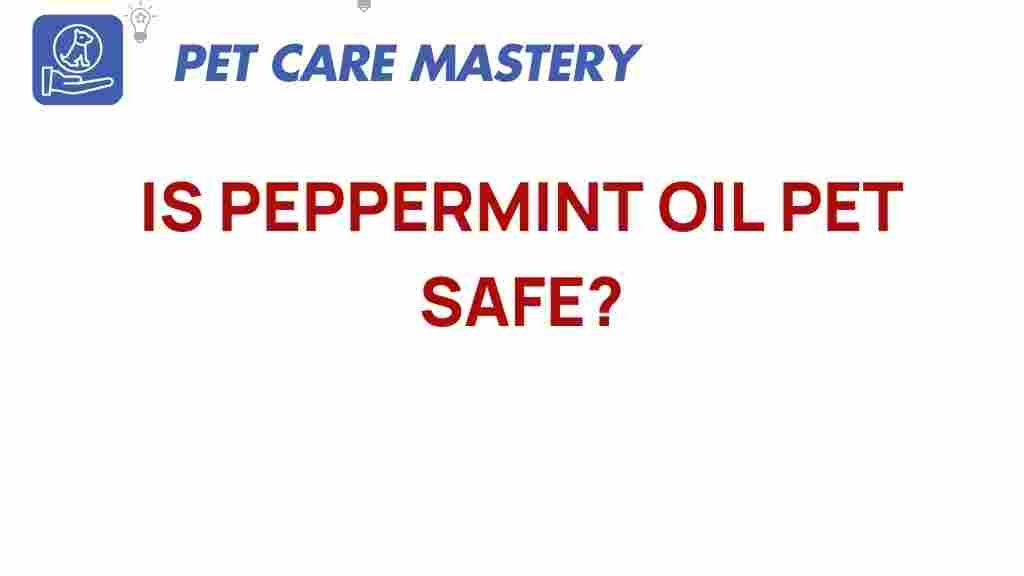Is Peppermint Oil Safe for Pets?
Peppermint oil has gained popularity for its numerous health benefits in humans, ranging from alleviating headaches to improving digestion. However, pet owners are increasingly curious about whether peppermint oil is safe for their furry companions. In this article, we will unveil the truth behind peppermint oil and its use around pets, including its potential benefits and risks.
Understanding Peppermint Oil
Peppermint oil is an essential oil derived from the leaves of the peppermint plant (Mentha × piperita). It contains menthol, menthone, and other compounds that are known for their soothing and aromatic properties. While peppermint oil is widely used in aromatherapy and for various home remedies, it is crucial to understand how it affects pets.
Benefits of Peppermint Oil for Pets
Despite the potential risks, some pet owners may find peppermint oil beneficial in certain situations. Here are a few potential uses:
- Repelling pests: Peppermint oil is known to deter insects such as fleas and ticks. A diluted solution can be sprayed on your pet’s coat or around the home to help keep these pests at bay.
- Soothing muscle pain: For older pets, a diluted application of peppermint oil may provide relief from muscle soreness and stiffness.
- Freshening breath: Some pet owners use peppermint oil to combat bad breath in dogs. However, it must be used cautiously and in moderation.
Risks of Using Peppermint Oil on Pets
While there are potential benefits, there are also significant risks associated with using peppermint oil on pets. Understanding these risks is essential for every pet owner:
- Toxicity: Peppermint oil can be toxic to pets if ingested in large quantities. Symptoms of toxicity may include vomiting, diarrhea, and lethargy.
- Skin irritations: Some pets may experience skin irritations when peppermint oil is applied topically. Always perform a patch test before full application.
- Respiratory issues: Diffusing peppermint oil in the air can cause respiratory distress in some pets, particularly in cats and small animals.
How to Use Peppermint Oil Safely Around Pets
If you decide to use peppermint oil in your home, follow these guidelines to minimize risks:
- Consult your veterinarian: Before introducing peppermint oil into your pet’s environment, it’s crucial to consult with your veterinarian. They can provide personalized advice based on your pet’s health and specific needs.
- Use in moderation: If using peppermint oil for its benefits, always dilute it with a carrier oil such as coconut or olive oil. A common dilution ratio is one drop of peppermint oil to several drops of carrier oil.
- Avoid direct application: Do not apply peppermint oil directly to your pet’s skin or fur without veterinary guidance.
- Monitor your pet: Always keep an eye on your pet after using peppermint oil to ensure they do not have an adverse reaction.
- Choose quality products: Purchase high-quality, 100% pure peppermint oil from reputable sources. Avoid products with additional ingredients that could be harmful to pets.
Step-by-Step Process for Using Peppermint Oil
If you have consulted your veterinarian and decided to use peppermint oil, follow this step-by-step process:
- Preparation: Gather your materials: high-quality peppermint oil, a carrier oil, and a small container for mixing.
- Mixing: In a small container, mix one drop of peppermint oil with 5-10 drops of carrier oil. Ensure it is well blended.
- Patch test: Apply a small amount of the diluted mixture to a small area of your pet’s skin. Wait 24 hours to see if there is any reaction.
- Application: If no reaction occurs, you can use the diluted mixture on your pet or in their environment. For example, you can apply it to your hands and then pet them or use it in a diffuser, ensuring your pet can leave the area if they wish.
- Observation: Monitor your pet closely for any signs of discomfort or adverse reactions over the next few days.
Troubleshooting Tips
If you notice any of the following issues after using peppermint oil, take these troubleshooting steps:
- Skin irritation: If you observe redness or irritation, wash the area with mild soap and water and discontinue use.
- Vomiting or diarrhea: If your pet shows symptoms of gastrointestinal distress, contact your veterinarian immediately.
- Respiratory distress: If your pet appears to be having trouble breathing, remove them from the area where peppermint oil was used and seek veterinary assistance.
Alternative Solutions for Pet Care
If you’re wary of using peppermint oil, there are several alternative solutions available for common pet issues:
- Essential oil alternatives: Choose pet-safe essential oils like lavender or chamomile, which are often considered safe for animals.
- Natural pest repellents: Use natural flea and tick repellents made specifically for pets. Many commercial products are formulated without harmful chemicals.
- Dental care: For bad breath, consider providing dental chews or using pet-safe toothpaste instead of relying on peppermint oil.
Conclusion
In summary, peppermint oil can offer some benefits for pets, such as repelling pests and soothing muscle pain. However, the risks associated with its use—particularly toxicity and respiratory issues—should not be overlooked. Always consult with a veterinarian before introducing new products into your pet’s routine, and prioritize their safety above all else. If you’re interested in learning more about pet-safe oils or alternative remedies, check out this resource for additional insights.
While peppermint oil can be beneficial when used correctly, ensuring the health and safety of your pets should be your top priority. By following guidelines and consulting with professionals, you can make informed decisions that keep your furry friends happy and healthy.
This article is in the category Health and created by PetCareMastery Team
